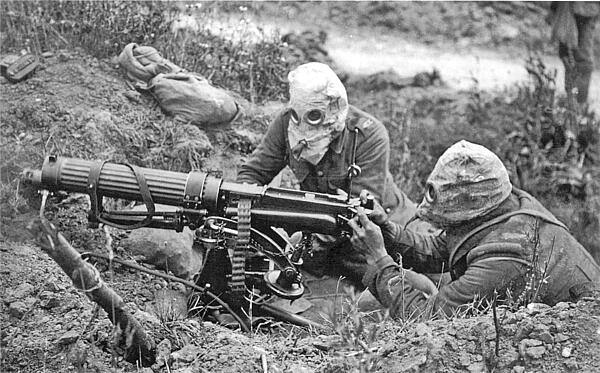1915 and World War One
1915 witnessed a number of major battles in World War One, not least at Gallipoli, Ypres and Loos. Trench Warfare was fully established and the troops were introduced to the horror of poison gas (chlorine) for the first time.
1 January: Battle of Soissons started.
14 January: Battle of Soissons ended after the Germans launched a successful counter-attack against the French.
15 January: The War Council authorised a naval attack on the Dardanelles.
19 January: The first Zeppelin raid on Great Britain took place at Great Yarmouth.
24 January: Battle of Dogger Bank between Royal Navy and the German Navy.
31 January: The first recognised use of poison gas took place at Bolimov on the Vistula Front.
3 February: Unsuccessful attacks on the Suez Canal by the Turks.
4 February: Germany declared the waters around Great Britain to be a ‘war zone’.
19 February: British troops bombarded Turkish forts in the Dardanelles. Small number of Marines landed.
24 February: A decision was taken that if the Navy could not defeat the defenders at the Dardanelles, then the task would be finished by the Army.
10 March: The British Army launched an offensive at Neuve Chapelle.
13 March: Mediterranean Expeditionary Force sailed from Egypt. Battle of Neuve Chapelle was ended.
18 March: An Anglo-French force that involved 16 battleships attacked the Dardanelles but suffered heavy losses.
22 March: Army and Navy commanders agreed on a joint offensive. Two Zeppelins attacked Paris.
11 April: British forces led by Sir John Nixon repel a Turkish attack on Basra.
22 April: First use of chlorine gas at the start of the Second Battle of Ypres.
25 April: Allied troops landed at five beaches at Gallipoli and gained a small beachhead at Anzac Cove.
26 April: A secret treaty between the Triple Entente and Italy brought Italy into the war on the side of the Allies.
1 May: First American merchant ship sunk by Germans, the ‘Gulflight’, a tanker, off the Scilly Islands
3 May: Italy denounced the Triple Alliance.

7 May: The ‘Lusitania’ was sunk by a German U-boat; 1,201 lives were lost including 128 Americans.
9 May: France launched a Spring Offensive in Artois and advanced towards Vimy Ridge.
19 May: The Turks launched a major attack to force the Allies out of Gallipoli. They suffered heavy casualties.
23 May: Italy declared war on Austria-Hungary.
24 May: A ceasefire was ordered for Anzac Cove to allow for the dead to be buried. The Austrian Navy bombarded Italian coastal towns and sunk the Italian destroyer ‘Turbine’.
25 May: ‘HMS Triumph’ sunk by U-21 off the Dardanelles. Second Battle of Ypres ended.
26 May: Italy announced that they would blockade Austria.
27 May: ‘HMS Majestic’ sunk by U-21 off the Dardanelles.
30 May: The Italians bombed the Austrians fleet base at Pula.
31 May: The first Zeppelin raid on London took place killing 28 and wounding 60.
18 June: The French Spring Offensive in Artois was ended.
20 June: The Germans launched an offensive in the Meuse-Argonne area.
23 June: First Battle of Isonzo.
1 July: Central War Industries Committee introduced to Germany and Austria-Hungary to co-ordinate war production.
7 July: First Battle of Isonzo ended with minor Italian victories.
12 July: German coal industry placed under state control.
13 July: The German offensive in Meuse-Argonne came to an end.
18 July: Second Battle of Isonzo started.
1 August: The start of the ‘Fokker Scourge’ with the Fokker monoplane dominant over the Western Front.
3 August: Second Battle of Isonzo ended with a total of 90,000 casualties but with minimal territorial gains for the Italians.
5 August: Germany captured Warsaw from the Russians.
6 August: Attempted breakout from Anzac Cove to capture nearby heights.
10 August: The Turks recapture lost land and forced the Allies back to Anzac Cove.
20 August: Italy started a sustained bombing campaign against Austrian military targets.
21 August: The 29th Division was ordered to attack Hill 60 and Scimitar Hill. The attack failed with heavy casualties.
1 September: Germany pledged that neutral ships would not be targeted in the sea war.
5 September: Nicholas II of Russia took full control of the Russian Army.
25 September: The British Army used poison gas for the first time at the Battle of Loos.
26 September: Start of Battle of Kut al-Amara.
28 September: End of Battle of Kut al-Amara; British forces defeated the Turks.
11 October: Bulgarian troops attacked Serbia.
14 October: The Battle of Loos ended.
18 October: Third Battle of Isonzo started.
4 November: Third Battle of Isonzo ended with no obvious gains for either side.
10 November: Lord Kitchener visited the Gallipoli front and decided to withdraw ANZAC forces there. Fourth Battle of Isonzo started.
25 November: The Serbian Army was ordered to retreat through Albania with the German Army in pursuit.
27 November: Very poor weather led to 15,000 troops being evacuated from Anzac Cove for frostbite, trench foot and exposure.
3 December: Fourth Battle of Isonzo ended with minimal territorial gains for Italy.
19 December: The Allies started the evacuation of Gallipoli. Douglas Haig replaced Sir John French as commander of the BEF.
MLA Citation/Reference
"1915 and World War One". HistoryLearning.com. 2026. Web.
